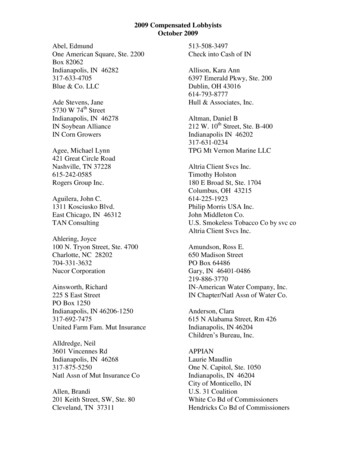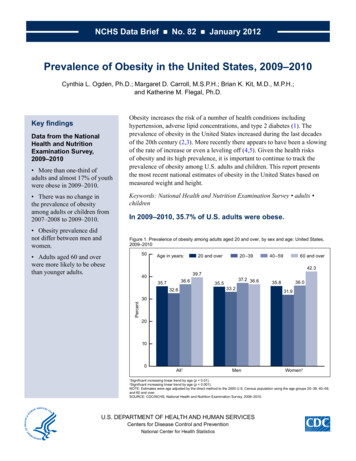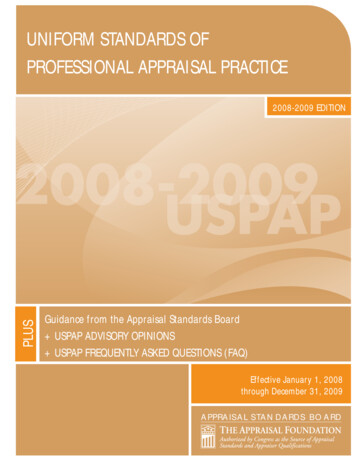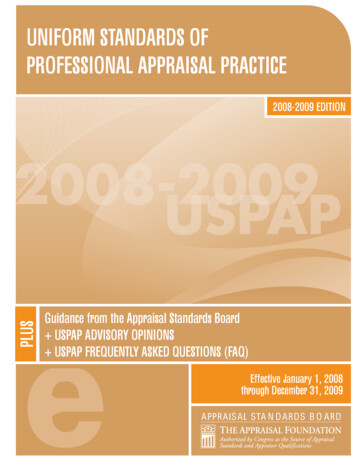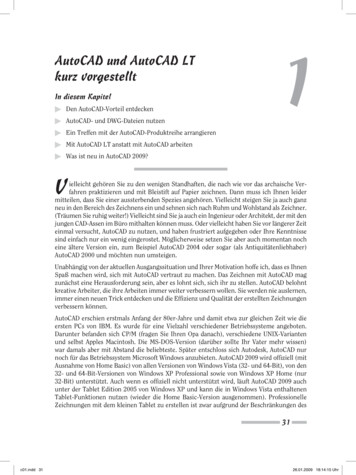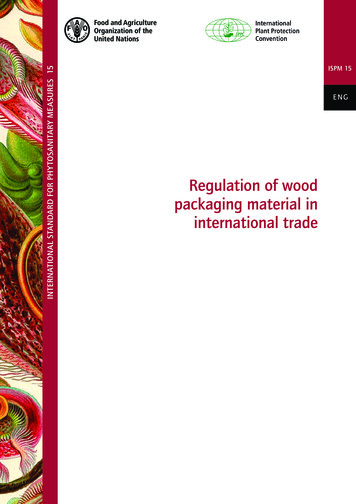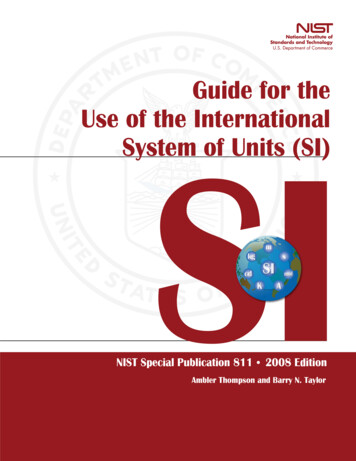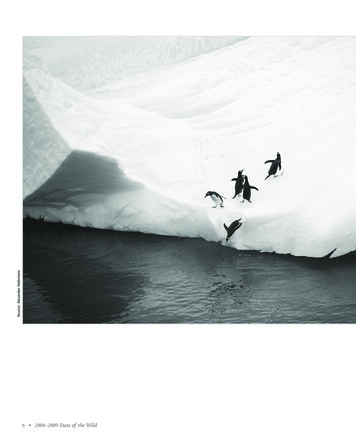
Transcription
Source: Alexander Hafemann6 2008–2009 State of the Wild
PERSPECTIVE OFA CLIMATOLOGISTntTipping PoiJAMES HANSEN“Animals are on the run. Plants are migrating too.”1 I wrote those words in 2006to draw attention to the fact that climate change was already under way. Peopledo not notice climate change because it is masked by day-to-day weather fluctuations, and we reside in comfortable homes. Animals and plants, on the otherhand, can survive only within certain climatic conditions, which are now changing. The National Arbor Day Foundation had to redraw its maps for the zones inwhich tree species can survive, and animals are shifting to new habitats as well.Are these gradual changes in the wild consistent with dramatic scientific assessments of a crystallizing planetary emergency? Unfortunately, yes. Present examples only hint at the scale of the planetary emergency that climate studies revealwith increasing clarity.Our home planet is dangerously near a tipping point at which human-madeJAMES HANSEN is director of the National Aeronautics and Space Administration Goddard Institute for Space Studies, but the perspectives here are his own. Hansen is also Adjunct Professor of Earth and Environmental Sciences at Columbia University’s Earth Institute, and he appeared in An Inconvenient Truth. He has also criticized theIntergovernmental Panel on Climate Change for not adequately addressing the danger oflarge sea level rise.Tipping Point 7
We are at the tipping point becausethe climate state includes large,ready positive feedbacks providedby the Arctic sea ice, the WestAntarctic ice sheet, and muchof Greenland’s ice.greenhouse gases reach alevel where major climatechanges can proceed mostlyunder their own momentum. Warming will shift climatic zones by intensifyingthe hydrologic cycle, affecting freshwater availabilityand human health. We will see repeated coastal tragedies associated withstorms and continuously rising sea levels. The implications are profound,and the only resolution is for humansto move to a fundamentally differentenergy pathway within a decade. Otherwise, it will be too late for one-thirdof the world’s animal and plant speciesand millions of the most vulnerablemembers of our own species.We may be able to preserve the remarkable planet on which civilizationdeveloped, but it will not be easy: special interests are resistant to changeand have inordinate power in our governments, especially in the UnitedStates. Understanding the nature andcauses of climate change is essential tocrafting solutions to our current crisis.Tipping PointEarth is heated by sunlight and, in balance, reaches a temperature such thatan amount of heat equal to the absorbed solar energy radiates back tospace. Climate forcings are imposed,temporary changes to Earth’s energybalance that alter Earth’s mean temperature. Forcings include changes in8 2008–2009 State of the Wildthe sun’s brightness, volcanic eruptions that discharge sunlight-reflectingparticles into the stratosphere, andlong-lived human-made greenhousegases that trap heat.Forcings are amplified or diminished by other changes within theclimate system, known as feedbacks.Fast feedbacks—changes that occurquickly in response to temperaturechange—amplify the initial temperature change, begetting additionalwarming. As the planet warms, fastfeedbacks include more water vapor,which traps additional heat, and lesssnow and sea ice, which exposes darksurfaces that absorb more sunlight.Slower feedbacks also exist. Due towarming, forests and shrubs are moving poleward into tundra regions. Expanding vegetation, darker than tundra, absorbs sunlight and warms theenvironment. Another slow feedbackis increasing wetness (i.e., darkness) ofthe Greenland and West Antarctica icesheets in the warm season. Finally, astundra melts, methane, a powerfulgreenhouse gas, is bubbling out. Paleoclimatic records confirm thatthe long-lived greenhouse gases—methane, carbon dioxide,and nitrous oxide—all increase with the warming ofoceans and land. These positive feedbacks amplify climate change over decades,centuries, and longer.The predominance ofpositive feedbacks explains whyEarth’s climate has historically undergone large swings: feedbacks work inboth directions, amplifying cooling, aswell as warming, forcings. In the past,feedbacks have caused Earth to bewhipsawed between colder andwarmer climates, even in response toweak forcings, such as slight changesin the tilt of Earth’s axis.2The second fundamental propertyof Earth’s climate system, partneringwith feedbacks, is the great inertia ofoceans and ice sheets. Given theoceans’ capacity to absorb heat, whena climate forcing (such as increasedgreenhouse gases) impacts global temperature, even after two or threedecades, only about half of the eventual surface warming has occurred. Icesheets also change slowly, although accumulating evidence shows that theycan disintegrate within centuries orperhaps even decades.The upshot of the combination ofinertia and feedbacks is that additionalclimate change is already “in thepipeline”: even if we stop increasinggreenhouse gases today, more warming will occur. This is sobering when
Source: Tom Vezo/naturepl.com.one considers the present status ofEarth’s climate. Human civilizationdeveloped during the Holocene (thepast 12,000 years). It has been warmenough to keep ice sheets off NorthAmerica and Europe, but cool enoughfor ice sheets to remain on Greenlandand Antarctica. With rapid warmingof 0.6 C in the past 30 years, globaltemperature is at its warmest level inthe Holocene.3The warming that has already occurred, the positive feedbacks thathave been set in motion, and the additional warming in the pipeline together have brought us to the precipice ofa planetary tipping point. We are atthe tipping point because the climatestate includes large, ready positivefeedbacks provided by the Arctic seaice, the West Antarctic ice sheet, andmuch of Greenland’s ice. Little additional forcing is needed to triggerthese feedbacks and magnify globalwarming. If we go over the edge, wewill transition to an environment faroutside the range that has been experienced by humanity, and there will beno return within any foreseeable future generation. Casualties would include more than the loss of indigenous ways of life in the Arctic andswamping of coastal cities. An intensified hydrologic cycle will produceboth greater floods and greaterdroughts. In the US, the semiaridstates from central Texas through Oklahoma and both Dakotas would be-Brünnich’s guillemot (Uria lomvia), an Arctic seabird, has advanced its egg-laying date atits southern boundary, a phenological change due to global warming.come more drought-prone and ill suited for agriculture, people, and currentwildlife. Africa would see a great expansion of dry areas, particularlysouthern Africa. Large populations inAsia and South America would losetheir primary dry season freshwatersource as glaciers disappear. A majorcasualty in all this will be wildlife.State of the WildClimate change is emerging while thewild is stressed by other pressures—habitat loss, overhunting, pollution,and invasive species—and it will magnify these stresses.Species will respond to warming atdiffering paces, affecting many othersthrough the web of ecological interac-tions. Phenological events, which aretimed events in the life cycle that areusually tied to seasons, may be disrupted. Examples of phenologicalevents include when leaves and flowers emerge and when animals departfor migration, breed, or hibernate. Ifspecies depend on each other duringthose times—for pollination or food—the pace at which they respond towarmer weather or precipitationchanges may cause unraveling, cascading effects within ecosystems.Animals and plants respond to climate changes by expanding, contracting, or shifting their ranges. Isotherms,lines of a specific average temperature, are moving poleward by approximately thirty-five miles (56 km) perTipping Point 9
Some species face extinction. The following examples represent a handful.Of particular concern are polar species,Source: Claire A. Zugmeyer.decade, meaning many species rangesmay in turn shift at that pace.4 Somealready are: the red fox is moving intoThe Mount Graham red squirrel (Tamiasciurus hudsonicus grahamensis) survives on asingle mountain in Arizona. “Green islands” on mountains, and the species that live onthem, are pushed higher as temperatures rise, and will be pushed off the planet if globalwarming continues.Arctic fox territory, and ecologists haveobserved that 943 species across alltaxa and ecosystems have exhibitedmeasurable changes in their phenologies and/or distribution over the pastseveral decades.5 However, their potential routes and habitat will be limited by geographic or human-made obstacles, and other species’ territories.Continued business-as-usual greenhouse gas emissions threaten manyecosystems, which together form thefabric of life on Earth and provide awide range of services to humanity.10 2008–2009 State of the Wildbecause they are being pushed off theplanet. In Antarctica, Adelie and emperor penguins are in decline, asshrinking sea ice has reduced the abundance of krill, their food source.6 Arctic polar bears already contend withmelting sea ice, from which they huntseals in colder months. As sea ice recedes earlier each year, populations ofpolar bears in Canada have declined byabout 20 percent, with the weight offemales and the number of survivingcubs decreasing a similar amount. Asof this writing, the US Fish andWildlife Service is still considering protecting polar bears, but only after itwas taken to court for failure to act onthe mounting evidence that polar bearswill suffer greatly due to global warming.7Life in many biologically diversealpine regions is similarly in danger ofbeing pushed off the planet. When agiven temperature range moves up amountain, the area with those climatic conditions becomes smaller androckier, and the air thinner, resultingin a struggle for survival for somealpine species.In the Southwest US, the endemicMount Graham red squirrel surviveson a single Arizona mountain, an “island in the sky,” an isolated green spotin the desert. The squirrels, protectedas an endangered species, had rebounded to a population of over 500,but their numbers have since declinedto between 100 and 200 animals.8 Lossof the red squirrel will alter the forestbecause its middens are a source offood and habitat for chipmunks, voles,and mice.A new stress on Graham redsquirrels is climatic: increased heat,drought, and fires. Heat-stressedforests are vulnerable to prolongedbeetle infestation and catastrophicfires. Rainfall still occurs, but it is erratic and heavy, and dry periods are moreintense. The resulting forest fires burnhotter, and the lower reaches of theforest cannot recover.
In the marine world, loggerheadturtles are also suffering. These greatcreatures return to beaches every twoto three years to bury a clutch of eggs.Hatchlings emerge after two monthsand head precariously to the sea toface a myriad of predators. Years ofconservation efforts to protect loggerhead turtles on their largest nestingarea in the US, stretching over 20 milesof Florida coastline, seemed to be stabilizing the South Florida subpopulation.9 Now climate change places anew stress on these turtles. Floridabeaches are increasingly lined with seawalls to protect against rising seas andstorms.Sandybeachesseaward of the walls are limitedand may be lost if the sea level risessubstantially.Some creatures seem more adaptable to climate change. The armadillo,a prehistoric critter that has beenaround for over 50 million years, is likely to extend its range northward in theUS. But the underlying cause of theclimatic threat to the Graham redsquirrel and other species—from grizzlies, whose springtime food sourcesmay shift, to the isolated State of the Planetsnow vole in the mountains of southern Spain—is There is a huge gap between what is“business-as-usual” use of understood about global warming—fossil fuels. Predicted by the scientific community—andwarming of several de- what is known about global warminggrees Celsius would surely —by those who need to know: thecause mass extinctions. public and policymakers.Prior major warmings inThe crystallizing science points toEarth’s history, the most recent occur- an imminent planetary emergency.ring 55 million years ago with the re- The dangerous level of carbon dioxlease of large amounts of Arctic ide, at which we will set in motion unmethane hydrates,10 resulted in the ex- stoppable changes, is at most 450 partstinction of half or more ofthe species then on theplanet.Might the Graham redsquirrel and snow vole be“saved” if we transplantthem to higher mountains? They would have tocompete for new niches—and there is a tangled webof interactions that hasevolved among speciesand ecosystems. What isthe prospect that wecould understand, letalone reproduce, these Loggerhead turtle (Caretta caretta) hatchling emergingcomplex interactions that from egg. Loggerhead decline has been arrested by theprotection of nesting areas on Florida beaches and othercreate ecological stability? measures, but these areas will be threatened by rising“Assisted migration” is sea level.thus an uncertain prospect.11 The best chance for all species per million (ppm), but it may be less.12is a conscious choice by humans to Carbon dioxide has already increasedpursue an alternative energy scenario from a preindustrial level of 280 ppmto stabilize the climate.to 383 ppm in 2007, and it is now increasing by about 2 ppm per year. WeTipping Point 11Source: Turtle Time, Inc.Prior major warmings inEarth’s history, the mostrecent occurring 55 millionyears ago . . . resulted inthe extinction of half ormore of the species thenon the planet.
Carbon dioxide contained in fossil fuel reservoirs, (a) the dark areas being the portionalready used; (b, c) cumulative fossil fuel carbon dioxide emissions by different countriesas a percent of global total; (d) per capita emissions for the 10 largest emitters of fossil fuelcarbon dioxide.must make significant changes withina decade to avoid setting in motionunstoppable climatic change.We need to address carbon dioxideemissions immediately. Global industrialization, powered first by coal, andlater by oil and gas, resulted in fossilfuel pollutants that choked London onsmog, set a river on fire in the US, anddamaged forests by acid rain. We aresolving those pollution problems, butwe did not address them until they hitus with full force. That approach, to12 2008–2009 State of the Wildwait and see and clean up the messpost facto, will not work in the case ofcarbon dioxide emissions and climatechange because of inertial effects,warming already in the pipeline, andtipping points. On the contrary, ignoring emissions would lock in catastrophic climatic change.Instead, we must resolve to moverapidly to the next phase of the industrial revolution—expanding the benefits of advanced technology to helpmaintain the atmosphere, and conse-quently the wonders of the naturalworld. A review of basic fossil fuelfacts reveals why the shift must bemade soon. Based on the estimatedamount of carbon dioxide locked ineach remaining fossil fuel reservoir—including oil, gas, coal, and unconventional fossil fuels (tar sands, tar shale,heavy oil, methane hydrates)13—burning readily available oil and gas resources alone will take atmosphericcarbon dioxide to levels near 450 ppm.Burning coal and unconventional fossil fuels, which energy companies arenow exploring, could take atmospheric carbon dioxide to far greater levels.To understand the limits on future
and massive extinctions—only if the planetary enerIn my view, special interestsgy balance is restored at anhave undue sway with ouracceptable global temperature. Temperature flucgovernments and havetuates from year to year,effectively promotedbut it is increasing byabout 0.2 C per decade.minimalist actions andAlthough estimates ofpermissiblewarminggrowth in fossil fuels, rathermust be refined as knowlthan making the scale ofedge advances, the upshotof crystallizing science isinvestments necessary.that the “safe” global temperature level is, at most,use of fossil fuels, an awareness of the about 1 C greater than the year 2000carbon cycle is critical. In this cycle, global temperature.This 1 C limit on additional globalthe ocean quickly takes up a fractionof carbon dioxide emissions, but up- warming implies the aforementionedtake slows as carbon dioxide added to carbon dioxide ceiling of about 450the ocean exerts a “back pressure.” ppm.14 Pinpointing this carbon dioxFurther uptake depends upon carbon ide ceiling is complicated due to otherdioxide mixing into the deep ocean human-made forcings, especiallyand precipitating out of ocean water methane, nitrous oxide, and “blackvia carbonate sediments. This means soot.” For example, an alternative scethat about one-third of carbon dioxide nario allows carbon dioxide levels toemissions remain in the atmosphere peak at 475 ppm because it assumes aafter 100 years and one-quarter still re- large reduction of methane.15 Howmain after 500 years. Indeed, carbon ever, human-made sulfate aerosolsdioxide from the Industrial Revolution (reflective particles that have a coolingstill around today implies heavy re- effect) are likely to decrease, neutralizsponsibilities for Europe and the US.ing these potential reductions inCarbon reservoirs and the ocean’s methane. Therefore 450 ppm is apace of removing carbon dioxide are good comprehensive estimate of theimportant boundary conditions in maximum allowable carbon dioxide.framing solutions to the climate crisis. Indeed, if recent ice loss fromWe can avert planetary transformation Antarctica is a sign, it may be—eventual disintegration of ice sheets that even 450 ppm is excessive.Since we could reach 450 ppmwithin two to three decades, weshould be inspired now to change ourenergy systems. Based on the preceding boundary conditions, the following is a four-point strategy to avoiddangerous climate change.1. Coal and unconventional fossilfuels must be curtailed andused only with capture andsequestration of the carbondioxide underground. Existingcoal-fired power plants shouldbe phased out over the next fewdecades.2. Carbon price and efficiencystandards must be implemented. Recognizing the unusualenergy concentration and mobility of fossil fuels—withwhich little else can currentlycompete—the practical way totransition to a postpetroleumera is to impose a moderate butcontinually rising carbon price.The price can be via a tax onfossil fuels, a ration-and-tradesystem that limits impacts onpeople least able to afford anenergy tax, or a combination ofmethods. This will make fossilfuels pay for environmentaldamage while stretching remaining oil and gas to accommodate sustainable economicgrowth. The certainty of arising price will inspire indusTipping Point 13
tries to innovate and will reduce the incentive to exploitunconventional fossil fuels withhigh carbon dioxide emissions,such as tar shale.In addition, we need realefficiency standards, for vehicles, buildings, and lighting. Wemust remove barriers to energyefficiency, such as the policy ofmost utility companies to promote energy consumptionrather than conservation.3. We must take steps to drawdown atmospheric carbondioxide. Farming and forestrypractices that enhance carbonretention in the soil and biosphere must be supported. Biofuel power plants with carbonsequestration can draw downatmospheric carbon dioxide,16putting anthropogenic carbondioxide back underground.Carbon dioxide can besequestered beneath oceansediments17 and in other safegeologic sites.4. We must take steps to reduceother, non–carbon dioxideforcings, especially black soot,methane, and ground-levelozone via stricter regulations.International implementation ofthese steps requires recognition of responsibilities. Because of the long lifetime of carbon dioxide already emit14 2008–2009 State of the Wildted, Europe bears a large responsibility. But the responsibility of the US ismore than three times that of anyother nation, and it will continue to bethe largest for at least several decades,even though China will exceed the USin new emissions within a year or two.Sadly, the requirements to avoidglobal disasters are not yet widely recognized: Germany intends to replacenuclear power plants with coal. ButEurope, the US, and other developedcountries should place a moratoriumon new coal-fired power plants untilcarbon capture and sequestration arein place. This cannot wait until similarrestrictions are practical in China andIndia. National responsibilities for climate change and per capita emissionsare an order of magnitude greater inthe US, Canada, and Australia than inIndia and China, and define moral obligations.At the same time, China and developing countries should bulldoze oldtechnology coal power plants andbuild new coal power plants with onlythe latest technology. Storms andfloods attending climate change willhit developing countries hardest because most megacities near sea levelare in those countries. This shouldprovide incentive for China and Indiato address climate change.Efficiency of future vehicle poweris also vital. California’s requirementfor 30 percent efficiency improvementhas great value. In contrast, a pro-posed national energy plan for 20 percent ethanol in vehicle fuels, derived inlarge part from corn, does more harmthan good. It will do little to reduceemissions—because producing ethanol currently requires a lot of energy—and it would degrade carbon retention in soils. There are ways that renewable or other carbon dioxide–freeenergies may eventually power vehicles, but half-measures should not bedictated without sufficient scientificinput to balance vested agribusinessinterests.That said, biofuels can play a majorpart in our energy future. As a nativeIowan, I like to imagine that the Midwest will rescue compatriots threatened by rising seas. Native grasses, appropriately cultivated, and perhapswith improved varieties, can drawdown atmospheric carbon dioxide.The prairies may contribute, if we geton with solving the climate problembefore superdrought hits them. Biofuel investment should proceed withinput from scientists and conservationists, because some industry andgovernment biofuel production planswould clear more forest for plantations of oil palm and soy with consequences for wildlife and wildlands.A Final PictureEarth’s paleoclimatic record tells usthat atmospheric greenhouse gases arenow near the dangerous level wheretipping points become unavoidable.
Source: Philippe Clement/naturepl.com.Yellow-bellied marmots (Marmota flaviventris) advanced their emergence from hibernationby 23 days in the Rocky Mountains, presumably due to global warming.We can choose a course to reversegreenhouse gas growth and promptlychange our energy strategy. A step inthe right direction was the April 2007decision by the US Supreme Court thatthe Environmental Protection Agencycan and should regulate greenhousegas emissions. However, much more isneeded.In my view, special interests haveundue sway with our governmentsand have effectively promoted minimalist actions and growth in fossilfuels, rather than making the scale ofinvestments necessary.US government complicity withspecial interests was clear when, at apractice press conference held byNASA on Arctic sea ice, a member ofmy group suggested that a reductionin greenhouse gas emissions couldstem sea ice loss. His suggestionprompted a government “minder” toproclaim “that’s unacceptable,” on thegrounds that it was a policy statement,when in fact it was scientifically based.While making policy is the right ofour elected representatives, scientistshad connected the dots of climate research and were prevented from communicating that information. In thiscase, vested interests posed a threat toour home planet and the fabric of lifeupon it.It is worth imagining how ourgrandchildren will look back on us.The picture that I fear has the polluters, the utilities, and automakersstanding in court demanding theright to continue to emit carbon dioxide for the sake of short-term profits.The disturbing part is that we,through our national government,are standing alongside the polluters,officially as a hulking amicus curiae(friend of the court), arguing againstlimitations on emissions. Is this thepicture of our generation that wewant to be remembered by?We live in a democracy, and policiesrepresent our collective will. If weallow the planet to pass tipping points,it will be hard to defend our role. Thestate of the wild is in our hands, andwe can still preserve creation and servehumanity worldwide. A drive for energy efficiency and clean energy sourceswill produce high-tech jobs. Restoration of clean air will be universally beneficial. Rural life and the planet canbenefit from intelligent developmentof biofuels and renewable energy.At the front lines, observing thechanges in the wild, conservationistsserve as a voice for the plants and animals that have already started reactingto climate warming. To conserve asmuch biodiversity as we can, conservationists must unite with many others to push for a far more radical reduction in carbon dioxide emissionsthan has hitherto been consideredpractical. Otherwise, alpine and polarspecies, coral reefs, and species livingin areas that become arid will be lostover the next century.nTipping Point 15
16. Anon. 2003; M. Fenton et al., “Linking bats to emerging diseases,” Science311(2006): 1098–99.17. J. Newcomb, “Thinking ahead: The business significance of an avian influenzapandemic,” Bio Economic Research Associates, 2006; Original source, J. Pritchett et al.,“Animal disease economic impacts: A survey of literature and typology of researchapproaches,” International Food and Agribusiness Management Review 8(2005).18. Centers for Disease Control and Prevention, Count07 detailed.htm.19. Tasmania Department of Primary Industries and Water, ?open; J. Bunce, “Tassie devil tumour breakthrough,” The Australian, Oct. 3, 2007.20. G. Vogel, “Tracking Ebola’s deadly march among wild apes,” Science 314(2006):1522–23; World Health Organization www.who.int/csr/don/2007 10 03a/en/index.html.21. Whirling Disease Initiative, http://whirlingdisease.montana.edu.22. “Trans-boundary diseases hamper livestock development,” Botswana PressAgency, June 27, 2005, www.gov.bw/cgi-bin/news.cgi?d 200506278: Trans-boundarydiseases hamper livestock development.Introduction: Future States of the Wild by Kent H. Redford1. J. Marshall, “Future Recall: Your Mind Can Slip through Time,” New Scientist,March 24, 2007.Part I: State of the WildTipping Point: Perspective of a Climatologist by James Hansen1. J. Hansen, “The Threat to the Planet,” New York Review of Books,, July 13, 2006.2. J. Hansen et al., “Climate Change and Trace Gases,” Philosophical Transaction ofthe Royal Society A 365 (2007): 1925–1954.3. J. Hansen et al., “Global Temperature Change,” Proceedings of the NationalAcademy of Sciences. 103 (2006): 14288–93.4. C. Parmesan, “Ecological and Evolutionary Response to Recent ClimateChange,” Annual Review of Ecology and Evolution of Systems 37 (2006): 637–69.5. C. Parmesan, “Ecological and Evolutionary Response,” 2006.6. L. Gross, “As the Antarctic Ice Pack Recedes, a Fragile Ecosystem Hangs in theBalance,” PLoS Biol 3, no. 4 (2005): e127.7. E. Pennisi, “U.S. Weighs Protection for Polar Bears,” Science 315 (2007): 25.8. C. Jordan, “Computers May Help Save Mount Graham Red Squirrel,” Univ.Arizona News, April 27, 2006; T. Egan, “Heat Invades Cool Heights over ArizonaDesert,” New York Times, March 27, 2007.9. Fish and Wildlife Service, Loggerhead Sea Turtle, gerheadsea-turtle.htm.10. D. Archer, “Methane Hydrates and Anthropogenic Climate Change,”Biogeosciences Discussion 4 (2007): 521–44.11. C. Zimmer, “A Radical Step to Preserve a Species: Assisted Migration,” New YorkTimes, January 23, 2007.12. J. Hansen et al., “Dangerous Human-Made Interference with Climate: A GISSmodel Study,” Atmospheric Chemistry and Physics Discussion 7 (2007): 2287–312.258 Notes
13. Proven and anticipated reserves are based on Energy InformationAdministration estimates. Other experts estimate higher or lower reserves, but theuncertainties do not alter our conclusions.14. J. Hansen, “Dangerous Human-Made Interference with Climate,” 2007.15. J. Hansen et al., “Global Warming in the Twenty-First Century: An AlternativeScenario,” Proceedings of the National Academy of Sciences 97 (2000): 9875–80.16. J. Hansen, Political Interference with Government Climate Change Science. Submitted text accompanying oral testimony given March 19, 2007 during hearings on“Political Interference with Science: Global Warming, Part II” of the Committee on Oversight and Government Reform of the U.S. House of Representatives. www.columbia.edu/ jeh1/20070319105800-43018.pdf; http://oversight.house.gov/story.asp?ID 121417. K. Z. House et al., “Permanent Carbon Dioxide Storage in Deep-SeaSediments,” Proceedings of the National Academy of Sciences 103 (2006): 12291–95.Discoveries by Margaret Kinnaird1. B. M. Beehler et al., “A New Species of Smoky Honeyeater (Meliphagidae:Melipotes) from Western New Guinea,” Auk 124 (2007): 1000–9.2. E. Kranz, “Scientists Believe Bird’s Head Seascape Is Richest on 9180601.xml.3. A. Singa et al. “Macaca Munzala: A New Species from Western ArunachalPradesh, Northeastern India,” International Journal of Primatology 26 (2005): 977–89.4. R. H. Bain et al., “Three New Indochinese Species of Cascade Frogs (Amphibia:Ranidae) Allied to Rana Archotaphus,” Copeia 1 (2006): 43–59.5. Bulletin of
a planetary tipping point. We are at the tipping point because the climate state includes large, ready positive feedbacks provided by the Arctic sea ice, the West Antarctic ice sheet, and much of Greenland's ice. Little addi-tional forcing is needed to trigger these feedbacks and magnify global warming. If we go over the edge, we
